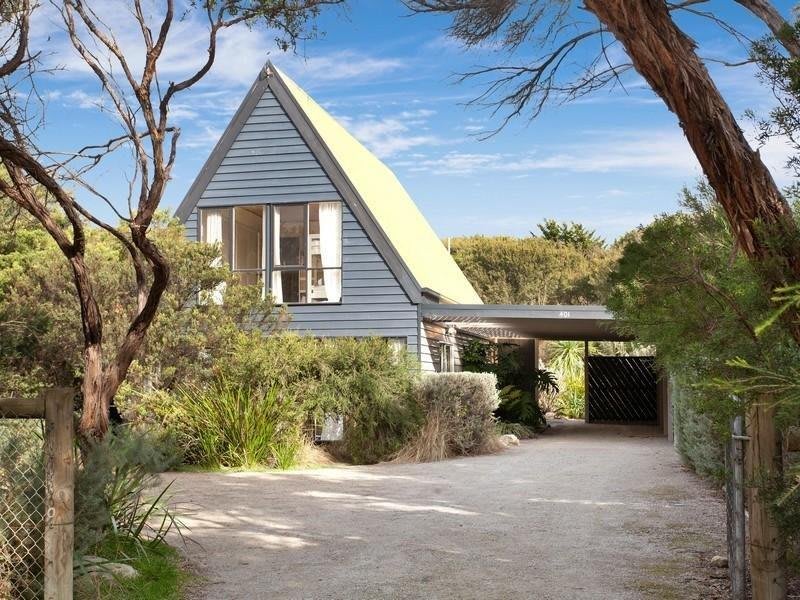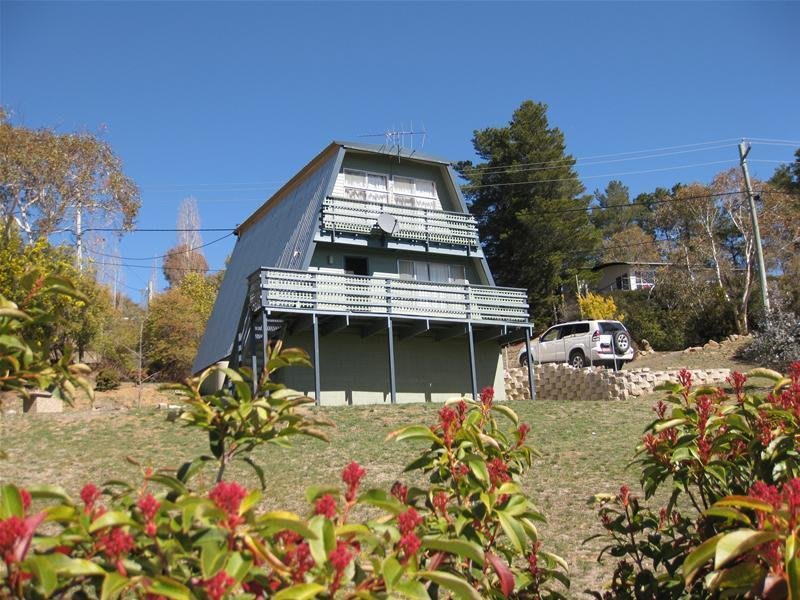A-Frame houses, do they work? He Said/She Said
HE SAID:

No – except in alpine regions where the design makes structural sense because the high-pitched roof line can handle a lot of snow without buckling under the stress.
While I appreciate the affordability of A-Frame houses, generally I think the designs are unattractive - especially when an extension is tacked on the side.
Often located in mountain and seaside locales, cartoonish looking A-Frame dwellings (mostly built during the 1950s, 60s and 70s) can be the least expensive houses for sale in a particular area due to their distinctive pyramid-shape design with limited buyer appeal.
Two weeks ago, a turquoise-blue painted A-Frame house at Callala Beach (on the NSW South Coast, pictured below) sold for $470,000 through Kelly Sprowles of Callala First National Callala Bay. Situated directly opposite the beach, the two-storey abode (with two bedrooms and two living areas) stands on an 803 square metre block.

In January, a twin A-Frame dwelling at Queensland’s Rainbow Beach (pictured below) sold for $310,000 through Rodney Gray of Rainbow Beach Realty. Sold as a deceased estate, the Cooloola Drive property was marketed as a holiday home or an investment opportunity given both dwellings were tenanted.

At Hobart in Tasmania, a one-bedroom A-Frame home (pictured below) sold for $240,000 last September through Mike Speakman of Petrusma Property Sandy Bay. Set on an elevated 1,955 square metre block in Fern Tree, the house has sweeping views to the ocean. With its huge glass walls, I think it looks like a hydroponic laboratory.

In Queensland’s Toowoomba, a substantial A-Frame house (on a 730 square metre block, pictured below) sold for $350,000 last September through Lynn Maclean of Real Point Property Toowoomba. Spanning three levels, it has been listed for sale through expressions of interest in the price range of $365,000 to $390,000.

On the market in Victoria’s South Gippsland hamlet of Mirboo North (located 155 kilometres east of Melbourne), an A-Frame three-bedroom house (pictured below) is for sale at $198,000 through Kaz Hughes of First National Real Estate Prom Country Mirboo North.

And at Lawson in the upper Blue Mountains of NSW, a two-bedroom A-Frame house at 29 Vista Avenue (pictured below) is for sale with price hopes of more than $319,000 through Gary Brown of First National Real Estate Mid-Mountains.

SHE SAID:
Yes – but I think A-Frame designs are only suited to coastal and mountain holiday houses.
I’m rather fond of the A-Frame shape with its minimalist modern style. Relaxed getaways and happy holidays are what the A-Frame is all about. Ideal for simple living and relaxed entertaining, these houses are designed to take advantage of mountain, lakefront or ocean views from floor-to-ceiling windows and outdoor decks.
Differing in size and style, A-Frame homes typically offer one-and-a-half to two or three levels of internal space with few vertical walls and an open-plan living area, sometimes with a fireplace or wood burning stove.
One such A-Frame that is ripe for a revamp is Wirreander at Mooney Mooney on the Hawkesbury River (pictured below). Owned by the same family for decades, it would be an idyllic weekender.
Set on 16.19 hectares and accessible only by boat, the property is being sold with all the house furnishings as well as a single cylinder generator, lawn mower, a 14 foot boat (with 40 hp motor) and a trailer.
For sale at $599,000 through Jeff Rudge of Hawkesbury River Real Estate Brooklyn, Wirreander is one of the priciest A-Frame holiday houses on the market near Sydney.

Characterized by a triangular roof, the A-Frame design was popularized from the mid-1950s to early 1970s by middle-class American families with money to spare on vacation cottages and second homes - and Australian families followed suit.
The first American A-Frame residence was a holiday house designed in 1936 by modernist architect, Rudolph Schindler, who worked with Frank Lloyd Wright. Set in a resort community on the hills above Lake Arrowhead in California, it was built for Gisela Bennati, a costume designer, who wanted an inexpensive holiday cottage.
Of open-plan design, Schindler’s house (pictured below) with its glass gables and A-shaped roof almost reaching the ground, was well ahead of its time.

Photo courtesy of About.com.
In 1951, John Carden Campbell, a San Francisco architect, received acclaim for his modernist A-Frame model (known as “Leisure House”) displayed at the Francisco Arts Festival. The following year, Campbell built his own “Leisure House” on a wooded hillside in Mill Valley, across from the Golden Gate Bridge. Featuring smooth plywood with all-white interiors, his simple and affordable A-frame designs spread nationwide via do-it-yourself kits and plans.

Photo courtesy of aframehistory.com
A-Frame holiday home designs propelled to prominence and took off like wildfire, after a house, designed by architect Andrew Geller, was featured in a 1957 edition of the New York Times. Known as Elizabeth Reece house, it was built in Sagaponack, New York.

Elizabeth Reese House, 1955, Sagaponack, New York, Courtesy of Jake Gorst/archpaper.com
After peaking in popularity during the 1960s, the enthusiasm for A-Frame vacation homes waned in the 1970s when people opted to build bigger holiday houses or buy holiday apartments in beachside areas.
Throughout Australia, A-Frame holiday houses often are listed for sale in beautiful coastal and mountain villages. An ideal weekender which traded recently is an A-Frame home at St Andrews Beach on Victoria’s Mornington Peninsula (pictured below). Sold for $451,ooo in December through Michael Christodoulou and Mal McInnes of Hocking Stuart Blairgowrie, it stands on a 856 square metre block in Sandy Road, just a few minutes walk from Rye Ocean Beach.

At Recherche, a beautiful bay on the south-eastern coast of Tasmania, the price of a substantial A-Frame holiday house recently was reduced by $73,000. For sale at $452,000, the Cockle Creek Road property (pictured below) is only 40 metres from the beach.
With beautiful water views across Recherche Bay to the Southern Ocean, the three-level A-Frame House is a self-sufficient home with solar power and a back-up generator. Also on the property is a separate two-bedroom wood heated unit. With a registered mooring in the bay, the property is located in a protected Wilderness and State Forest area with excellent fishing and magnificent bushwalking on the doorstep.

Also in Tasmania, an A-Frame holiday cottage at Sisters Beach is for sale (with all its goods and chattels on a “walk-in walk-out” basis, pictured below) with price hopes of more than $200,000 through Dennis Wragg of Roberts Real Estate Wynyard. Near Rocky Cape National Park on the island’s north-west coast, Sisters Beach is renowned for its long sandy beach, fishing, boating and bushwalking on tracks through the National Park.

For Victorian ski enthusiasts, a modern A-Frame holiday house at Dinner Plain (13 kilometres from Mount Hotham) is for sale at $520,000 through Lee Rourke of John H Castran Pty Ltd Melbourne. With five bedrooms, two bathrooms, a sauna and two storerooms, the vast snow chalet (pictured below) could be used in summer as well as during the season for Dinner Plain offers a wide range of summer activities including bush walking, horse riding, mountain biking and tennis.

While Jonathan and I don’t agree about most things A-Frame, we do concur the style of A-Frame houses with a chopped-off roof is a hideous. Examples of this style can be seen in the NSW Snowy Mountains town of East Jindabyne where a two-level A-Frame house sold for $225,ooo four years ago.
Marketed as the cheapest freestanding house in East Jindabyne or Jindabyne, it was built in the early 1960s as a fishing and skiing getaway. This A-frame shape was typical of many holiday homes built in East Jindabyne at that time.

